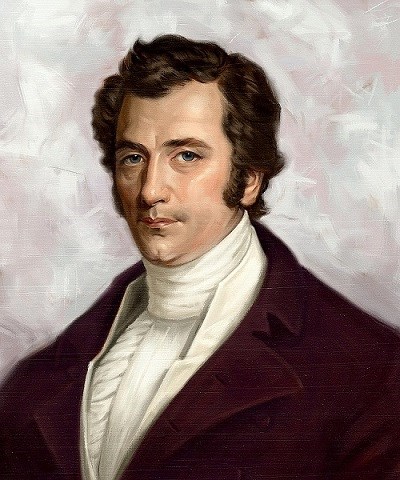
Image Courtesy of Robert Carter Early YearsDavid Thompson was born on April 30, 1770 in Westminster, England. At the age of 2, his father died and he was raised along with his older brother by his widowed mother. When he was 7 years old, he and his brother were sent to the Grey Coat School in London, a charity school for working class and unprivileged children. Early on, Thompson developed an aptitude for mathematics. He also learned the basics of navigation including the use of a sextant and cross staff. Both the British Navy and the Hudson’s Bay Company, a fur trading company with operations in North America, were looking for individuals with these particular skills. At 14 years of age, Thompson received an apprenticeship for the Hudson’s Bay Company and was sent to North America to be a clerk. He learned aspects of the fur trade and became exposed to several Native American tribes, their culture, and their language. After breaking his right leg, he took the time during his recovery to learn basic cartography skills, geography, and astronomy skills. After his apprenticeship, he received several cartographical devices and almanacs to become a mapmaker and surveyor for the Hudson’s Bay Company. He changed employers to the rival North West Company in 1797. For the next 10 years, Thompson conducted several ventures to the Canadian Rockies to chart maps, make detail sketches and journal notes of the terrain, to establish trade with the Native Americans, and establish several fur trading posts.
Lake Roosevelt National Recreation Area Fur TradeThe fur trade was a highly profitable business for European-Americans on the North American continent. For centuries, fur trappers and traders ventured throughout the eastern and central portion of the continent to trade manufactured goods, rifles, tobacco, and alcohol with Native American tribes in exchange for animal furs, particularly the beaver pelt. Furs and pelts were shipped to European textile factories to be made into high class fashion. Men wore the beaver top hat made out of beaver pelt. They were a status of high class society and were oftentimes passed down to their children. Women wore scarves, hats, and other clothing items made from various animal furs. But by the 1800s, fur traders needed new areas as the once rich supply of animals became depleted. The Pacific Northwest was one of the last areas yet to be tapped into. Finding the "Northwest Passage"For centuries, European explorers have tried to find a direct northwest water route through North America to the Pacific Ocean in order to travel to the rich, profitable silk and spice market in Asia. The searched seamed elusive and mariners were forced to travel around the southern tip of South America to go to Asia. In 1792, American sea captain Robert Gray and British mariner George Vancouver separately discovered the mouth of the Columbia River. During 1805-06, American explorers Merriweather Lewis and William Clark led the Corps of Discovery Expedition and traversed the southern portion of the Columbia River. 
Lake Roosevelt National Recreation Area Kettle FallsOn June 19, 1811, Thompson travelled by horseback to Kettle Falls on the Upper Columbia River, becoming the first recorded Euro-American to do so. Kettle Falls was the second largest salmon fishery on the Columbia River and he came during a time when representatives and tradesmen from tribes from a 200-mile radius around the falls came to fish, trade, share news, settle old quarrels, and more. For the next two weeks, Thompson and his men stayed at Kettle Falls while they fashioned a makeshift canoe. He took several journal entries of the falls and the people who gathered there. Thompson wrote, “The Salmon in the Columbia River, and some of its Branches, is a peculiar fish, and precautions must be used to prevent its leaving its spawning ground, and although the Natives have, what appeared to me, superstitions on this fish, yet experience taught us, that the Natives knew the habits of the Salmon better than we did, of which I made experiments, and confirmed to me, they were right.” One of his men fell in the river and spooked the salmon. LegacyOn July 3, 1811, Thompson and his party left Kettle Falls. Eight days later, they reached the mouth of the Pacific Ocean. Later that year, Thompson navigated upstream the entire length of the river, becoming the first person to do so. The Columbia River expedition would also be the last major accomplishment of his fur trading career. The following year, Thompson retired from the North West Company and the fur trade. He continued to work as a surveyor and a mapmaker for the British government for several years. In all, Thompson travelled over 55,000 miles during his lifetime and mapped an area of 1.5 million square miles, nearly 1/5 of the entire North American continent. The maps he made were so detailed and accurate both the American and Canadian government used them until the 1940s. But Thompson's legacy and his coming to the Pacific Northwest and Kettle Falls would have profound impact on the cultural landscape, both good and bad. A fur trading post Thompson wanted at the falls would not happen until 1825 with the establishment of Fort Colvile. The fur trade under the Hudson's Bay Company dominated the economics and maintained control of the Pacific Northwest for the British until 1846. Soon after, gold was found in the region. The influx of settlers and miners brought diseases upon the Native Americans. A series of reservation policies ignited several conflicts throughout the region. Grand Coulee Dam was completed in 1941, thereby drowning the falls Thompson came to 130 years earlier. |
Last updated: January 10, 2024
